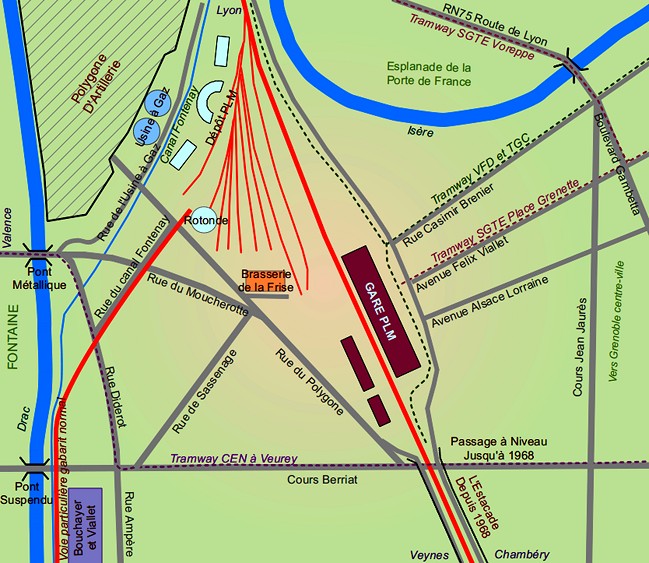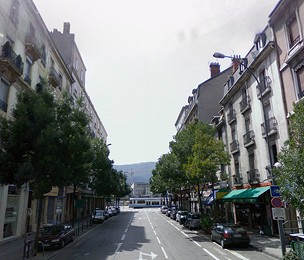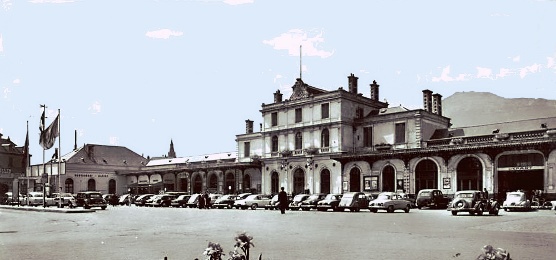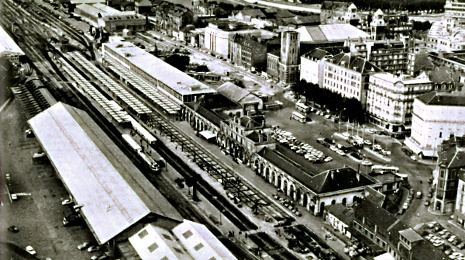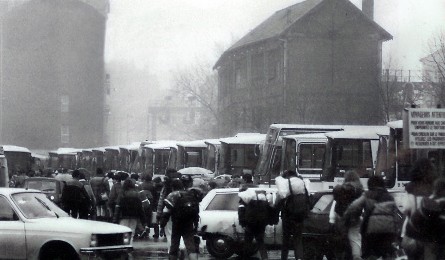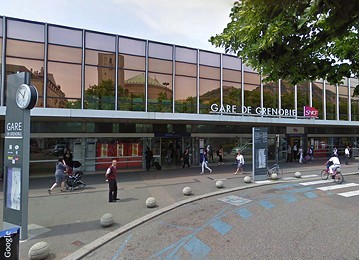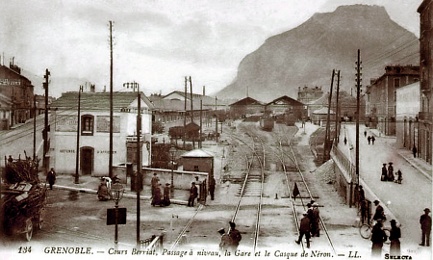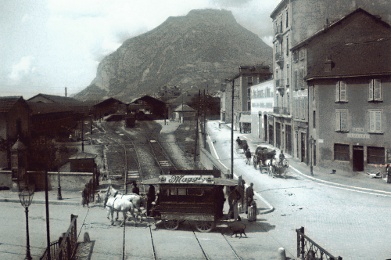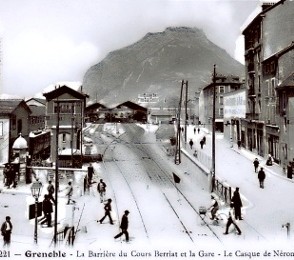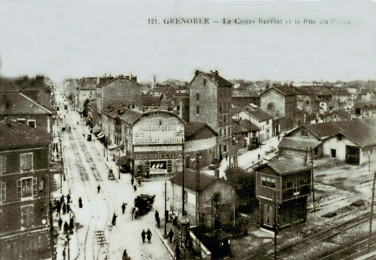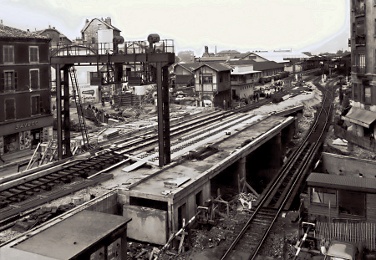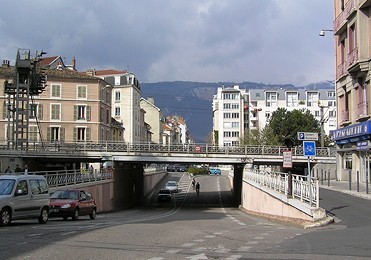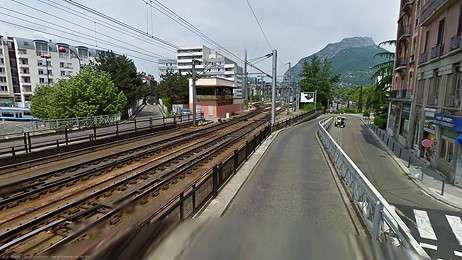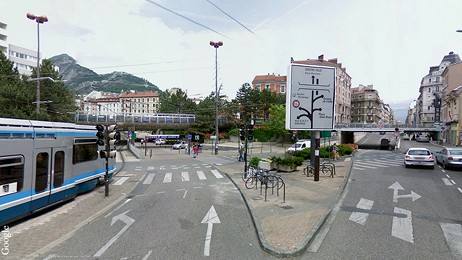Grenoble -around the Railway.
5- Around and about the Railway Station, towards the city centre.
-disused,
forgotten, taken away or abandoned lines.
5- Around and about the Railway Station, towards the city centre.
All
the pictures can be enlarged with a mouse click!
The avenue Felix Viallet, once a centre of life
animated by the passage of the SGTE tramway going to the Station from
Place Grenette, is now quite calm. With the change in position of the
new station, now aligned with the rue Casimir Brenier, the focus is now
transferred to Avenue Alsace Lorraine and the tramway station for the
lines A and B.
In both images, we see some changes, the tobacconist has changed to the sunny side.
In both images, we see some changes, the tobacconist has changed to the sunny side.
With the 1968 Olympics, Grenoble wanted to show another
face, the Grenoble futuristic. Initially, the new station was built
next to the old.
Then the demolition of the old station created the space for the new bus station next to the postal sorting office at that time.
With the advent of the modern tramway in 1987, a tram station was created on the site of the old railway station and mail sorting depot.
A modern bus station was built on the other side of the railway station.
From there, the tramway 'A' for Fontaine joins the Cours Berriat, like the old SGTE tram used to do.
The tramway 'B' continues to its current terminus at the International City and the Law Courts on the site of the former Frise brewery and the former locomotive depot.
Then the demolition of the old station created the space for the new bus station next to the postal sorting office at that time.
With the advent of the modern tramway in 1987, a tram station was created on the site of the old railway station and mail sorting depot.
A modern bus station was built on the other side of the railway station.
From there, the tramway 'A' for Fontaine joins the Cours Berriat, like the old SGTE tram used to do.
The tramway 'B' continues to its current terminus at the International City and the Law Courts on the site of the former Frise brewery and the former locomotive depot.
A lot of industries had developed between the 'Cours
Saint André' and the Drac, encouraged by a plentiful supply of water
and the presence of the railway. Saint Bruno has became the town at the
entrance to Grenoble with its church and its growing population. There
are, even now, diverse types of housing, flats, houses, more or less
pretty, and even some mansions. All these people needed to cross the
railway to go to the town centre, not to mention people coming from
villages on the other side of the Drac and travellers from the Vercors,
Romans and Valence (The Catane bridge was not built until 1956). This
explains the many railway level crossings.
These obstacles to traffic flow became unacceptable for a city that wanted to modernise itself and host the Olympic Games.
The solution found was to build a viaduct from the station to the 'Boulevard Marechal Foch' bridge, itself divided between the railroad tracks from Chambery and Veynes. So, by doing this, three or four level crossings were erradicated in one go.
This viaduct, known affectionately as the 'Estacade' hosts a daily market of fresh produce. It also provides the support for a vast fresco of folk art concerning the market and the railway.
To avoid too great a slope for the railway, however, the 'Cours Berriat' had to be lowered. For the modern tram, another underpass was also created alongside.
These obstacles to traffic flow became unacceptable for a city that wanted to modernise itself and host the Olympic Games.
The solution found was to build a viaduct from the station to the 'Boulevard Marechal Foch' bridge, itself divided between the railroad tracks from Chambery and Veynes. So, by doing this, three or four level crossings were erradicated in one go.
This viaduct, known affectionately as the 'Estacade' hosts a daily market of fresh produce. It also provides the support for a vast fresco of folk art concerning the market and the railway.
To avoid too great a slope for the railway, however, the 'Cours Berriat' had to be lowered. For the modern tram, another underpass was also created alongside.
Completion of the 'Estacade' really changed the nature
of this district which is very important for the development of
Grenoble. Even now, the 'Cours Berriat' is the main access to Europole,
Minatec, the CENG, the ILL and a growing number of companies and
educational organizations. The other access is by the A480 motorway at
the 'Felix Esclangon' exit , which was once, as we have seen, the
'Canal
Fontenay'.
For several years, the trolley bus for Fountain took the underpass until the service was replaced by the tram 'A' in 1987.
The old SGTE tramway never had this possibility because it was done away with in 1938.
Currently trams 'A' and 'B' cross the tracks via an underpass near the tram stop at the railway station.
For several years, the trolley bus for Fountain took the underpass until the service was replaced by the tram 'A' in 1987.
The old SGTE tramway never had this possibility because it was done away with in 1938.
Currently trams 'A' and 'B' cross the tracks via an underpass near the tram stop at the railway station.
Some Internet Links:
- http://www.hannibal-dans-les-alpes.com/
- http://1900anosjours.hpsam.info/photos/grenoble/exposition-internationale-1925.php
- http://insitu.revues.org/217#tocto1n2
- http://www.rocadesud.com/realisations/?actmenu=estacade&ID_rubrique=4
- http://www.artmajeur.com/?go=artworks/display_mini_gallery&image_id=2564745&login=nesse
- http://www.arcachon-nostalgie.com/roger_expert.htm
- http://insitu.revues.org/217#tocto1n2
- http://histoire.trains-en-vadrouille.com
- http://www.euro-photos-trains.com/sncf67300BBC.htm
- http://cccp.trainprovence.free.fr/cccp/article-alpazur2007.html
- http://clode.chez-alice.fr/fretgrenoble.htm
- http://www.lineoz.net/forum/viewtopic.php?f=3&t=3657&start=0
- http://membres.multimania.fr/stephanerevel/histo.htm
- http://www.ville-st-martin-dheres.fr/industrialistation.html
- http://emmatortue.wordpress.com/2009/05/15/ces-biscuits-ont-fait-les-delices-de-mon-enfance/
- La Vie du Rail, N°'s 1104, 1129, 1131 et 1137, Éditions NM Paris, 1967 et 1968.
- Le Bassin du Drac, Auguste Bouchayer. Revue de géographie alpine. Tome 13 N°3. pp. 549-621. 1925.
- Histoire Populaire de Grenoble, Alphonse Vernet. Gratier, 1896.
- Le Chemin de Fer de Grenoble à Villard de Lans. Philippe Guirimand et Patrice Bouillon, 2000.
- Grenoble Autrefois, Jean-Jacques de Corcelles. Horvath, 1996.
- Une Industrie dans la Ville, Bouchayer & Viallet à Grenoble. Hervé Bienfait. Libris, 2004.
- L'Illustration Economique et Financière, numéro spécial, Grenoble et l'Isère, 1923.
- Les Voies Ferrées du Dauphiné, Henri Boyer et Patrice Bouillon, 1983.
- Guide Catalogue Officiel de l'Exposition Internationale de la Houille Blanche et du Tourisme, Saumane 1925.
- Grenoble Autrefois, Claude Muller, Editions des Quatre Seigneurs, 1974.
- Du Tram au Tag, JM Guétat, W Lachenal, G Muller, La Vie du Rail,1987.
